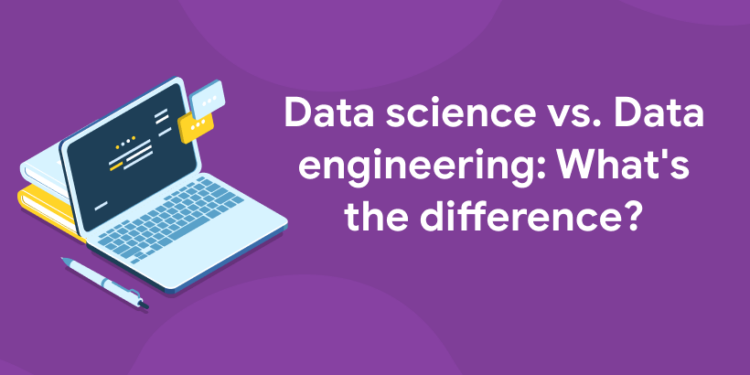Table of Contents
Data science and data engineering are two closely related fields, so it’s easy to see how you might mistake one for the other. In order to make sure that you’re not caught off guard by any differences in the way these two fields work, we’ve put together this handy list of the ten most important points that separate data science from data engineering. If you have any additional thoughts on the subject, feel free to comment below! While there are plenty of similarities between data science and data engineering, there are also differences between the two professions that many people may not expect. While it’s sometimes easy to confuse data science and data engineering, the two are very different disciplines with different goals, responsibilities, and skillsets. The best data scientists and data engineers are familiar with each other’s work and how the two disciplines operate. These differences can range from the types of problems that you’re looking to solve to the tools you’ll use to do so, which makes it important to consider your options before deciding on either career path. Here are 10 major differences in data science vs. data engineering that might surprise you.
Get the latest updates on data science in the Entri app
What Is Data Engineering?
Although data scientists and data engineers are constantly interacting, it’s not uncommon for confusion to arise as to what each of them does, how they relate to one another, and what exactly their roles entail. First, let’s look at their similarities: both data scientists and data engineers are generally analytical individuals with a love for statistics who have some experience working with large amounts of data (perhaps it was part of your undergraduate degree or something you picked up on your own time). As more organizations integrate big-data technologies into their business processes and operational management systems, demand for data engineers is growing rapidly (there were 538 job openings listed on LinkedIn on May 19th). A good way to start is by gaining familiarity with some of their key terms. Here are 10 key terms from data science vs. data engineering that might surprise you . For example, did you know that data engineering uses RDBMSs but data science does not? Or that all machine learning techniques can be divided into two categories: supervised and unsupervised? Also included here are links to relevant resources where you can learn more about these topics.
To get the latest updates on data science in the Entri app
The Type Of People Who Get Attracted To These Fields
The data science and data engineers are from very different mindsets, with skillsets that also complement each other as well as a few overlaps between them. The data scientists are more about dealing with spreadsheets and business intelligence or writing algorithms for applications like Amazon, Facebook etc., while data engineers work closely with hardware systems to run analytics on vast amounts of information using things like Hadoop platforms and related tools such as Cassandra, MongoDB, S3 etc., storing terabytes of information on distributed computer systems. Difference #2 – What they do: Both these fields deal with data but their end goals are totally different. A data scientist is someone who takes raw information collected by an organization and uses it to draw conclusions or inferences from it which can be used by managers and executives to make better decisions based on real-time insights into what’s happening within their organizations. A data engineer is someone who works directly with computers, networks, servers, and storage systems working out how best to store large amounts of raw unstructured data so that it can be accessed quickly by various departments within an organization for analysis purposes.
Enroll in our latest data science course in the Entri app
Type Of Problems Tackled
The success of any data science project depends on how much technical knowledge and basic data literacy a business has available to its users. Data engineering projects, by their very nature, have more access to user education because of the complexity and all-encompassing nature of software development practices. On other hand, data scientists can occasionally need coaching to understand why they should ask certain questions or think about finding answers in specific ways (i.e., business friendly). This additional training comes at a cost and time spent educating your team can be considered part of your data scientist’s overhead/cost as well. That is not to say that data engineers are inherently better than data scientists; it just means there are different types of problems being tackled depending on which role you hire for. This entry was posted on Wednesday, December 9th, 2015 at 11:00 am and is filed under Uncategorized. You can follow any responses to this entry through the RSS 2.0 feed. Both comments and pings are currently closed.
Get free placement assistance with the Entri app
Productivity And Resource Management
Another difference between data scientists and data engineers is their productivity, which has to do with resource management. Data Scientists typically work in an environment where they have access to all of their resources: servers, software, and computing power. In contrast, a data engineer works within a specific structure where many other people are constantly changing things around him or her. Working within a finite set of resources requires one to constantly optimize and manage those resources to accomplish optimal output for results-oriented organizations like Google, Amazon, or Facebook. As a result, Data Engineers tend to be more productive than data scientists when it comes to delivering real business value. A good example of how Google manages its resources is through their more wood behind fewer arrows philosophy – We need to develop our top priorities and make sure we have enough people on them. (Google SVP Urs Hölzle). This means that at any given time there will be only 10 projects at Google receiving full attention from top talent (the best coders) across all of Google’s products.
To know more about data science in the Entri app
Data Literacy Among Users
Users of data are well-aware of what they have and can use it as required. The number of people with good domain knowledge about a particular application domain or business process is greater than those familiar with an entire organization’s data assets, their structure, and how to apply them to their work. This makes discussions between these two groups a significant challenge for organizations trying to leverage their data assets to support more business value delivery through analytics. It is important for teams bridging these two user groups to be aware of both parties’ expectations when building out analytical systems (what information will be provided, what will be returned, what techniques will be used) so there aren’t surprises on either side during project execution or when new features/data sources are added later. Understanding what information users expect from data versus what actually exists can also help build trust within your team and promote acceptance of analytics projects.
As an example, I worked at a healthcare company where all products were classified into one of four Categories based on product type (see below). When we built our first dashboard using our enterprise data warehouse, we were very surprised to find that almost none of our salespeople knew how to read or interpret a pie chart! We spent some time with each salesperson working through different types of charts and then training them to better understand all visualizations we created going forward.
Get free placement assistance with the Entri app
How Results Are Evaluated?
If a data scientist produces an algorithm, then it is up to someone else to determine if it is any good or not. The evaluation for decision-making purposes generally falls on business stakeholders, who have no real data-science training and typically have a limited ability to evaluate new models and algorithms. In contrast, a data engineer has more control over how his/her results are evaluated. A data engineer can build code into their model to compare its performance against previous results or other models. This provides more accountability because they can use metrics such as mean absolute error (MAE) to measure how well their model performed against previous results. They can also compare their model’s performance against other similar models within their organization using metrics such as Root Mean Squared Error (RMSE).
To know more about data science in the Entri app
The Breadth Of Tools Used
A data scientist needs to be familiar with a broader range of tools than a data engineer. They need to know more about tools used for ETL and visualization, and also a bit about machine learning algorithms, databases, and optimization techniques (some data scientists even dabble in programming). A data engineer is much more focused on moving volumes of data from one place to another using whatever tool is most appropriate for a given problem. For example: if you are moving 1TB of data every day from your relational database into Hadoop, it doesn’t really matter if it takes 5 minutes or 15 minutes to do so – as long as it’s done consistently. On the other hand, if you have 1000 training instances and one false positive would cost $100k – then time becomes an important factor! In summary, a data scientist needs to understand why things work and what trade-offs they make when choosing their tools. A data engineer just uses whatever works best for the task at hand.
Get the latest updates on data science in the Entri app
The Computing Environment Used
This can be surprising to many who assume both disciplines use a lot of open source software and cloud services, but data engineers are far more likely to be writing custom code than most data scientists are. In fact, although Hadoop is almost a default for data science (and there’s good reason for that) it’s rarely used at all by data engineers – instead preferring proprietary tools or DIY platforms such as those offered by Qubole or MapR Cloud Services. One big difference between Python and R is packages created specifically for specific analytics needs are almost nonexistent in R while they’re extremely common with Python thanks to its popularity. For example, if you want to do machine learning on images using Python, scikit-image has everything you need; if you want to do machine learning on images using R, your best bet is probably installing an image package from GitHub. The only exception here would be Spark which has support for both languages but tends towards being easier in Python because of its simplicity and intuitive nature.
To know more about data science in the Entri app
The Data Lifecycle Followed
In a data engineering project, after the collection of data and documentation, it is archived for future analysis. In comparison, in a data science project, after being documented, it is only analyzed and not archived anywhere. So if something goes wrong with analyzing or its usage, later on, there is no way to reverse back to an earlier state where things were working fine with a high confidence level. This results in a loss of time and money spent while creating models as well as building infrastructure for support of those models. Difference #9 – The domain knowledge required: A data engineer requires domain knowledge of his/her area (like finance, telecommunication, etc.) which is usually done by reading books, blogs, and attending conferences. But in the case of a data scientist, he/she requires deep expertise in all domains like statistics, machine learning, etc., since it involves understanding new concepts continuously. Difference #10 – The work performed: A typical day at work for a data engineer involves doing hands-on coding, testing code to make sure they are bugs-free, and then deploying them into a production environment.
Get the latest updates on data science in the Entri app
The Skills Required To Work In Each Field
While data scientist is a mix of both computer science and statistics, data engineers need more IT skills, database-related skills, and overall knowledge of storage solutions such as HDFS or SSDs. The tools used: While the toolset for data scientists is comparatively huge (R, SQL, Hadoop/Spark, Tableau) compared to what a data engineer needs (RDBMS), each tool does some jobs better than others. For example, Spark can be used for RDD operations but for transformations it has its limitations so SQL comes in handy. Same goes with tableau. The size of datasets handled by each field: As mentioned above, since data engineers work with structured datasets they have smaller datasets when compared to unstructured ones handled by a data scientist. Integration with other teams: Since data engineer works mostly with structured datasets and their main job is ETL processing which involves integration with other teams such as marketing, product management etc., they interact much more frequently when compared to a data scientist who works mostly alone in silos. If you are interested to learn new coding skills, the Entri app will help you to acquire them very easily. Entri app is following a structural study plan so that the students can learn very easily. If you don’t have a coding background, it won’t be any problem. You can download the Entri app from the google play store and enroll in your favorite course.











